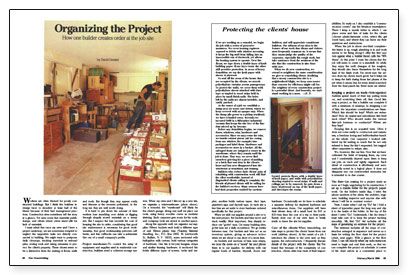
Synopsis: This business-oriented article offers ideas on managing your projects. Included are a flow chart designed to keep a job moving efficiently and details on organizing tools, materials, and people. A sidebar has ideas for protecting a client’s house from damage during a job.
Workers are often blamed for poorly constructed buildings. But I think the builders in charge have to shoulder at least half of the blame because of their bad management practices. Construction sites sometimes tell the story at a glance. I’ve seen some that resemble public dumps, and others where crews stand idle for lack of materials.
I must admit that once my crew and I have a project underway, we are sometimes tempted to neglect the supportive tasks not directly connected to building. We might want to postpone daily cleanups, stacking materials in rational piles, storing tools and taking measures to protect the client’s property. These chores seem to be a distraction from the making of floors, walls and roofs. But though they may appear costly and irksome at the moment performed, in the long run they are well worth doing.
It is hard to pin down the amount of time workers lose stumbling over debris or digging through sloppily stored materials on a messy site. But I suspect the loss exceeds the cost of keeping the site in order, considering that good site maintenance is necessary for good workmanship, that good workmanship prevents callbacks, and that callbacks can take a substantial bite out of a small company’s profits.
Project Warehouse
To control the array of equipment and supplies used in residential construction, builders need a coherent storage system. When my crew and I first set up a new site, we organize a mini-warehouse. On a remodel, the “warehouse” will likely be the client’s garage. Along one wall we place our tools, using heavy wooden crates as modular shelving. Each carpenter gets room for his tools, and company tools are stored in another space.
Along the opposite wall, we organize our supplies. Fifteen buckets each hold a different type of nail. Fifteen plastic bins (Turnkey Material Handling, Inc.), some sectioned with half-gallon milk cartons, hold various categories of hardware. One bin is for joist hangers, straps and similar framing hardware. A sectioned bin holds different types of screws, tacks and stasibilities. So early on I also establish a “communication corner,” say the fireplace mantelpiece. There I keep a manila folder in which I can place notes and lists of tasks for the clients (choose plastic-laminate color, select tile, get towel bars), and where they can leave me their questions and instructions.
When the job is about one-third complete — the frame is up, rough plumbing is in and work seems to be flying along — I offer the first caution against what a builder friend calls the “90% blues.” At this point I warn the clients that the job will seem to come to a standstill. So while they enjoy the swift changes of the rough-in, they should also brace themselves for the long haul of the finish work. I’m never sure the advice does my clients much good, but it helps me to keep the faith during those last phases of the job when it seems that for every detail scratched from the final punch list, three more are added.
For more photos, charts, and details, click the View PDF button below:
Fine Homebuilding Recommended Products
Fine Homebuilding receives a commission for items purchased through links on this site, including Amazon Associates and other affiliate advertising programs.

A Field Guide to American Houses

Original Speed Square

Plate Level


























